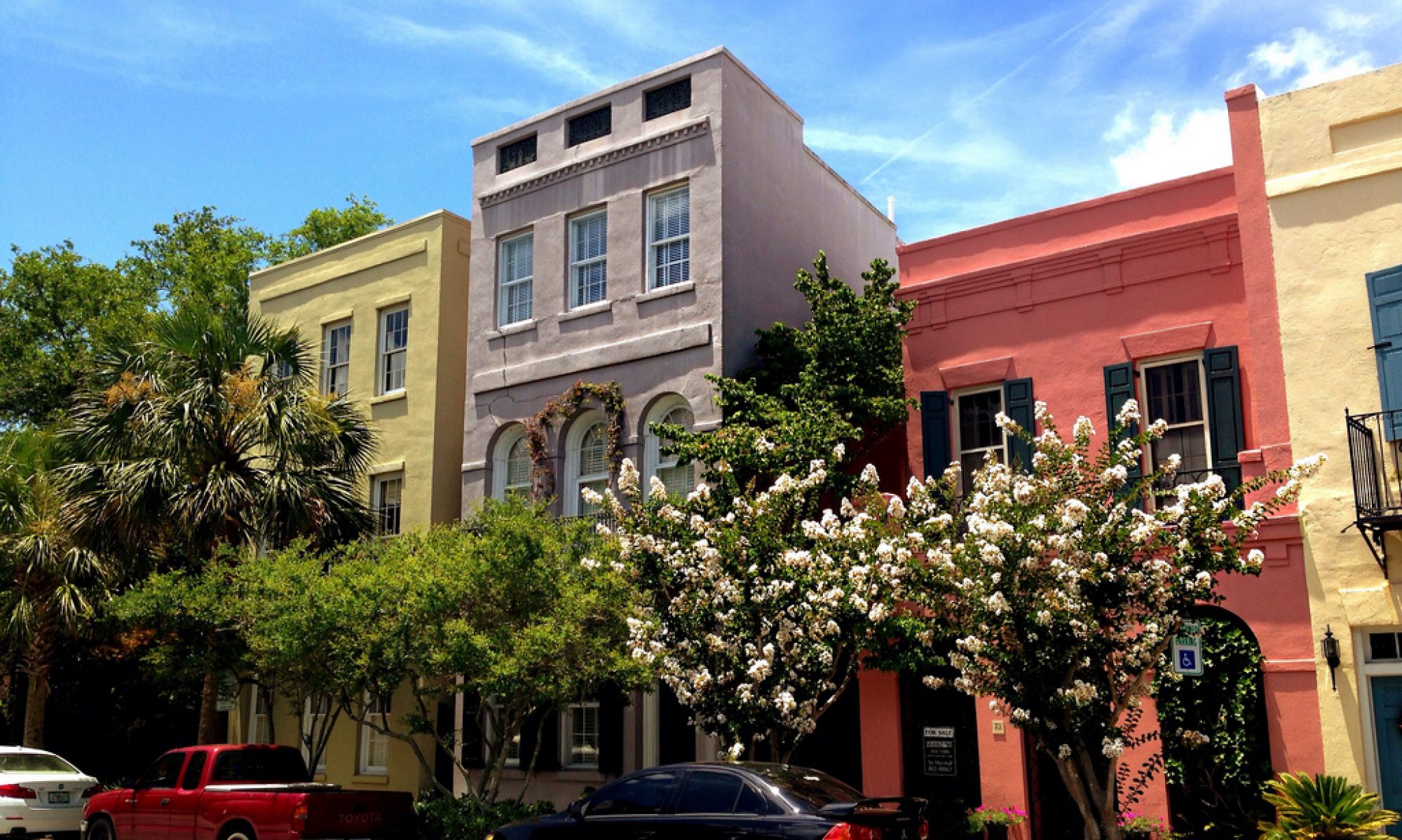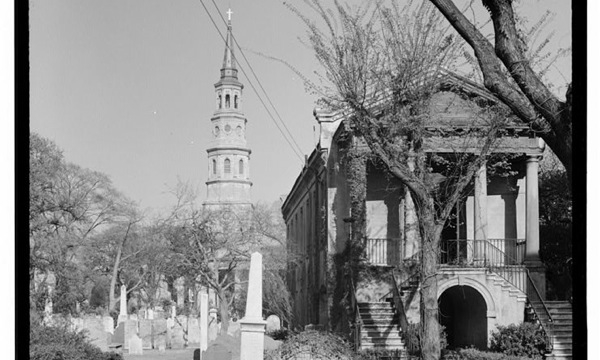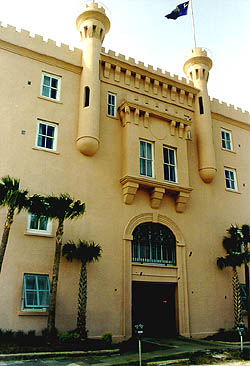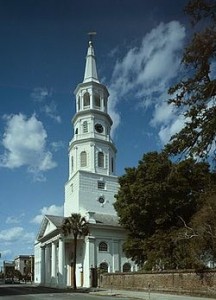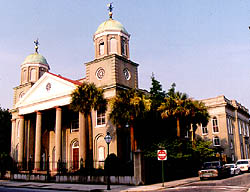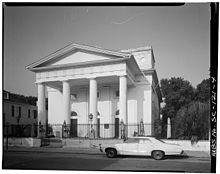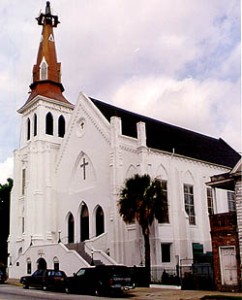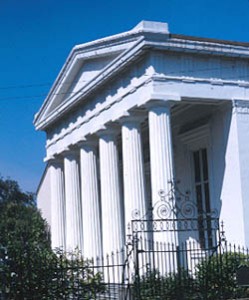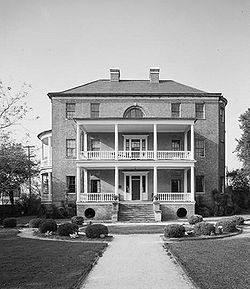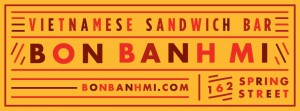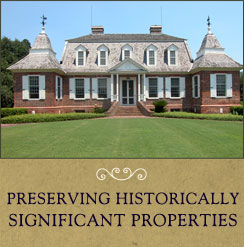Picture source – http://www.circularchurch.org
150 Meeting Street Charleston, SC 29401 843-577-6400 www.circularchurch.org/ ‘…one of the oldest continuously worshipping congregations in the South. Among highlights of our history are:- Charles Towne’s original settlers founded this protestant, or dissenting, church about 1681.-The graveyard is the city’s oldest burial grounds with monuments dating from 1695.- The first meeting house on this site gave Meeting Street its name.- The third structure here, a vast, circular hall built in 1804, burned in 1861.- Bricks from “Old Circular” were used in building the present sanctuary, completed in 1892.- Historically Independent: the congregation is now related to the United Church of Christ and thePresbyterian Church (U.S.A.).- Circular Church remains a vibrant, diverse community. Visitors are welcome both to explore the grounds and to explore the faith in worship, ministry, and life in community.’Source – http://bit.ly/skpsh8The Old Citadel or the South Carolina State Arsenal – Charleston, S.C. (Embassy Suites)
Picture and text source – http://1.usa.gov/uSa0UW
337 Meeting Street Charleston, SC – 29403 843-723-6900 1.usa.gov/uSa0UW Now a hotel, the building is open to the public.’‘The S.C. State Arsenal, more commonly known as the Old Citadel, is associated with several aspects of Charlestons history.
The impetus for the Arsenals construction in the early 1830s was the 1822 slave revolt led by Denmark Vesey.
In 1842 the S.C. Military Academy, a liberal arts military college, was established by the state legislature.
The new Academy took over the arsenal the following year, and the school soon became know as The Citadel in reference to the fortress-like appearance of the building.
Many Citadel alumni fought in the Civil War.
Cadets remained at the school but were periodically ordered by the governor to support the Confederacy, and helped drill recruits, manufacture ammunition, protect arms depots, and guard Union prisoners.
Citadel cadets were responsible for firing the first shots of the Civil War, January 9, 1861, at the Union relief vessel approaching Fort Sumter.
From 1865 to 1881, during Reconstruction in Charleston, Federal troops occupied the Citadel and the school was closed.
Classes resumed at the Citadel in 1882, and continued here until the school was relocated to a campus on the banks of the Ashley River in 1922.’
For more information on the architecure, etc. visit the National Park Service Website.
Today the Old Citadel is home to Embassy Suites Hotel.
St. Michaels Church – Charleston S.C.
Picture Source – Wikipedia
71 Broad Street, Charleston, SC – 29401 843-723-0603 ‘St. Michael’s Episcopal Church is an historic Episcopal church and the oldest surviving religious structure in Charleston, South Carolina. It is located at Broad and Meeting streets on one of the Four Corners of the Law, and represents ecclesiastical law. It was built in the 1750s by order of the South Carolina Assembly. It is listed on the National Register of Historic Places and is aNational Historic Landmark. It is still an active church in the Episcopal Diocese of South Carolina. ‘Source – Wikipedia Virtual Tour – may not work on mobile phonesFirst Scots Presbyterian Church, Charleston, S.C.
Source – National Park Service 53 Meeting Street Charleston, SC – 29401 843-722-8882 ‘First Scots Presbyterian Church, the fifth oldest church in Charleston, was constructed in 1814. Its design was perhaps inspired by St. Mary’s Cathedral in Baltimore, Maryland designed by Benjamin Latrobe. Latrobe was the first professionally trained American architect, best known for designing the United States Capitol. The massive brick Presbyterian Church has walls that are three feet thick and covered with stucco. Twin towers rise above a columned portico. Reflecting the heritage of the congregation, the seal of the Church of Scotland is displayed in the stained glass window over the main entrance, and the decorative wrought iron grilles contain thistles, the symbol of Scotland. First Scots replaced the congregation’s first church, a frame building previously located in the southeast corner of the graveyard. The graveyard contains more than 50 stones that date earlier than 1800.’
Source – National Park Service
To learn more about the history of the building, the meetings of the church body and natural disaster tragedies visit the National Park Service Website.
‘The church is open to the public 8:30am to 5:00pm Monday- Friday.
Call 843-722-8882 for further information.’
First Baptist Church – Charleston, S.C.
Picture Source – Wikipedia
‘The congregation was founded in 1682 under the leadership ofWilliam Screven.
It is one of the oldest Baptist congregations in the American South.’
Source – Wikipedia
48 Meeting Street Charleston, SC – 29401 843-722-3896 www.fbcharleston.org/Emanuel African Methodist Episcopal (AME) Church
Source – National Park Service
Open to the public Mon.-Fri. 9:00am to 1:00pm and 2:00pm to 4:00pm.
110 Calhoun Street Charleston, SC – 29401 843-722-2561‘The Emanuel African Methodist Episcopal (AME) Church is a Gothic Revival style church built in 1891.
Retaining its original alter, communion rail, pews, and light fixtures the church is one of only a few unaltered religious interiors in Charleston, especially from the Victorian period.
The brick Gothic church with its tall steeple replaced an earlier 1872 church badly damaged by the 1886 earthquake.
Today Emanuel is the oldest AME church in the South, and houses the oldest black congregation south of Baltimore, Maryland.
The history of this congregation reflects the development of religious institutions for African Americans in Charleston.
Its roots stem from a religious group of free blacks and slaves organized in 1791.
In 1816, black members of Charleston’s Methodist Episcopal church withdrew over disputed burial ground, and under the leadership of Morris Brown, formed a separate congregation. The church’s 1400 members soon thereafter established themselves an African Methodist Episcopal church, a denomination formally established in 1816 in Philadelphia, Pennsylvania.
Two years later, Brown and other ministers of the church were jailed for violating state and local laws which prohibited religious gatherings of slaves and free blacks independent of white supervision.’
Source – National Park Service
To learn more about a planned slave revolt and the burning of the church during the crisis and more see the National Park Service Website.
Kahal Kadosh Beth Elohim Synagogue – a Landmark
Listed in National Register of Historic Places.
Picture Source – National Park Service
90 Hasell Street, Charleston, SC – 29401 843-723-1090‘Founded in 1749 as a Sephardic Orthodox congregation, in 1841, Kahal Kadosh Beth Elohim-also known as KKBE-was firmly committed to the path of religious Reform Judaism.
Our sanctuary is the second oldest synagogue building in the United States and the oldest in continuous use.
We invite you to experience for yourself KKBEs rich past and vibrant present.’
Tours:
– Monday through Thursday from 10-noon and 1:30-3:30
– Fridays from 10-noon
– Sundays from 1:00-4:00
‘Our enthusiastic and knowledgable volunteer docents lead tours of the historic Sanctuary at KKBE and share our unique history.
Please allow at least 30 minutes for the tour plus time to visit our Museum and Chosen Treasures, our Sisterhood Judaica & Gift shop.’
‘Kahal Kadosh Beth Elohim Synagogue, a National Historic Landmark, is the country’s second oldest synagogue and the oldest in continuous use. The American Reform Judaism movement originated at this site in 1824. The congregation of Kahal Kadosh Beth Elohim-meaning Holy Congregation House of God-was established in colonial Charleston in 1749, and is now the nation’s fourth oldest Jewish community. The building reflects the history of Jewish worship in Charleston, as well as the high degree of religious tolerance within the Carolina colony.’‘The Beth Elohim congregation began as an Orthodox community, founded primarily by Sephardic immigrants (of Spanish and Portuguese ancestry).
By the end of the 18th century the Beth Elohim congregation had become the largest Jewish community in the nation, with a membership of 500.
This synagogue was built in 1840, on the site of the congregations first synagogue destroyed in the Charleston fire of 1838.
The building is an excellent example of the Greek Revival style, as its form, portico and rich ornamentation are adapted from classic Greek temples.
Designed by New York architect Cyrus L. Warner, the temple was built by congregation member, David Lopez.’
Sources:
For more infromation on the Synagogue visit the National Park Service Website or Wikipedia.
Joseph Manigault House – Charleston, S.C.
‘Rice was South Carolina’s economic base in the early 19th century.
Profits from growing and trading it made possible the buildings which comprise Charleston’s noted architectural heritage.
Among the most elegant of these is The Charleston Museum’s Joseph Manigault House, a National Historic Landmark, located in downtown Charleston close to the Museum and the City Visitor Center.’
Source – The Charleston Museum Website
350 Meeting Street, Charleston, SC – 29403 843-722-2996www.charlestonmuseum.org/joseph-manigault-house
Bon Banh Mi – Vietnamese Sandwich Bar, Charleston, S.C.
162 Spring Street
Charleston, S.C.
843-414-7320
Hours
Tue – Thu: 11:00 am-9:00 pm
Fri – Sat: 11:00 am-11:00 pm
Their mission: “We are on a mission to give you a well prepared, thoughtful sandwich. One with the power to single handedly change the way you think of sandwiches. A sandwich with so much history — one bite, and you are darn near transported.”
Historic Charleston Foundation
At the heart of the Foundation’s mission lie its preservation and advocacy programs, including protective covenants and easements. Learn more about the fascinating history of the Walled City of Charleston through photos, maps and video!
- The Charleston Museum ‘The Walled City’ Webpage
- The Mayor’s ‘Walled City’ Task Force Blog
- A video – ‘Archaelogy and the Walled City of Charleston (39 minutes)
40 East Bay Street, Charleston, SC 29401 843-723-1623
